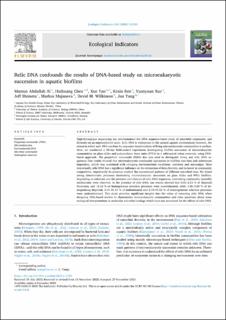Relic DNA confounds the results of DNA-based study on microeukaryotic succession in aquatic biofilms
Abdullah Al, Mamun; Chen, Huihuang; Yan, Xue; Ren, Kevin; Xue, Yuanyuan; Shimeta, Jeff; Majaneva, Markus; Wilkinson, David M.; Yang, Jun
Peer reviewed, Journal article
Published version

Åpne
Permanent lenke
https://hdl.handle.net/11250/3110610Utgivelsesdato
2023Metadata
Vis full innførselSamlinger
- Publikasjoner fra CRIStin - NINA [2397]
- Scientific publications [1423]
Originalversjon
10.1016/j.ecolind.2023.111350Sammendrag
High-throughput sequencing has revolutionized the DNA sequence-based study of microbial community and diversity on an unprecedented scale. Relic DNA is widespread in the natural aquatic environment; however, the extent to which such DNA can bias the sequence-based analysis of living microeukaryotic communities is unclear. Here, we conducted a 30-day field-control experiment investigating biofilm succession of microeukaryotic communities on glass slides and polyurethane foam units (PFUs) in a subtropical urban reservoir, using DNAbased approach. The propidium monoazide (PMA) dye was used to distinguish living and relic DNA sequences. Our results showed that microeukaryotic community succession in biofilms was time and substratum dependent, which was correlated with changing environmental conditions, nutrients and microalgae. Most importantly, relic DNA has a significant influence on the estimation of beta diversity and turnover in community composition, importantly its presence masked the successional patterns of different microbial taxa. We found strong deterministic processes dominating microeukaryotic succession on glass slides and PFUs biofilms. Depending on substrate and the presence and absence of relic DNA sequences, contrasting community assembly mechanisms were observed. In the presence of relic DNA, our results showed that 0.53–3.15 % of dispersal limitation, and 13.16 % of homogeneous selection processes were overestimated, while 1.06–3.68 % of homogenizing dispersal, 2.11–10.53 % of undominated and 2.10–10.52 % of heterogeneous selection processes were underestimated. This study provides significant insights into the value of removing relic DNA when designing DNA-based studies to characterize microeukaryotic communities and raise questions about some ecological interpretations in molecular microbial ecology which have not accounted for the effects of relic DNA.
